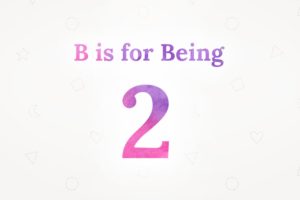Let’s not forget the ‘self’ in self-help
Practicing self-acceptance can be challenging while we’re holding beliefs that we should be thinking, feeling, doing or being something different to how we are. But unconditional acceptance of ourselves has the power to completely dissolve our strongest beliefs of inadequacy.
In this episode I take a look at two of the dynamics which can result from using self-help material before we’ve accepted our current mental/emotional state. These dynamics can keep us running in circles of feeling inadequate and then seeking temporary relief, without actually addressing the core of how we feel.
I share some of my own experiences and challenging times with accepting myself and how I realised I was using self-help material against myself instead of for genuine self-understanding and growth.
Highlights and Takeaways
- We can use self-help material as ammunition against ourselves.
- Using self-help material as a temporary fix is easy to do but doesn’t touch our underlying core beliefs of feeling inadequate.
- All self-help material is designed to help us. But if we skip ourselves in the process we’re missing out the most important part.
- Accepting how you are right now dissolves any feelings of ‘I’m not good enough and I need to be better.
- Accepting ourselves is us accepting everything that we’re thinking and feeling right now.
- It feels counter intuitive to accept such a strong unpleasant reaction.
- It takes courage to completely accept everything you’re experiencing right now.
- Acceptance is an on going practice. It’s not something you do once or twice and then you’re done.
Show Notes
- Ben: If we don’t accept how we are right now (thoughts, feelings, our current level of clarity and confusion) and go straight to trying to fix ourselves with self-help material, it’s very easy for us to use this new information to reinforce a belief that we are not good enough as we are right now. That we are inherently inadequate.
- We can use self-help material as ‘quick-fixes’ for our feelings of inadequacy. When we just look for these fixes and haven’t accepted ourselves first, we may feel temporarily better when we apply these fixes or read some comforting words but we need to keep coming back and finding new material, new inspiring words, new words of healing and hope for us to feel better again. And it’s possible to continue this process for a very long time without actually addressing our deeper core beliefs of inadequacy, brokenness, wrongness, etc.
- Without accepting what’s already there inside us (before searching for self-help material) we can easily slip into just looking for these quick fixes and staying in this cycle of not really changing anything for ourselves, but applying these ‘temporary relief band aids.’ We feel a bit better for a short time and then those feelings come back and we have to do it again. So nothing really ever shifts in that process.
How We Use Self-Help Material Against Ourselves
- As I mentioned first – we can use self-help material as ammunition against ourselves to reinforce our belief that we should be better than we are.
- I was reading The Power of Now a few years ago, obviously that’s a book that’s been designed to help people. There’s a lot of information about how to step out of compulsive thinking. At the time I was reading this, my belief that I should be better than I was, was still very strong. And I’m reading this information and thinking, ‘oh my god, I’ve got to stop thinking’ and every time I had a thought I started beating myself up for always being out of the moment, ‘ahhh I shouldn’t be thinking!’ ‘ah I can’t do this.’ ‘This book is telling me I should just be in the moment and stop thinking but I can’t even do that.’ So I wasn’t really encouraging myself along the way.
- I could have been accepting that I had just started learning a new skill, but instead I was focused on all the things I was getting wrong.
All self-help material is designed to help us. But if we skip ourselves in the process of self-help and go straight to the help, we’re leaving out the most important part of the process.
- When we do that we are attempting to look outside ourselves for the solution to our unpleasant feelings. And we think that the right words, the perfect meditation, the most powerful workshop will make these unpleasant feelings go away. The heart of the problem is us feeling like we should be different to how we are right now and that we should be fixed.
- As long as we keep coming from a place of not accepting how we are right now (a place of non-acceptance) and looking outside of ourselves for a way to fix how we feel, we’ll continue feeling like there’s something wrong with us, like there’s something to fix.
- We can easily slip into this never-ending cycle of feeling inadequate and searching for a fix.
Never-Ending Cycle of Inadequacy
- We feel inadequate, broken, wrong or that we shouldn’t feel how we’re feeling.
- We search for a solution, a fix, a cover up (self-help course, food, sex, alcohol, drugs.)
- We feel better for a while.
- Then the fix wears off and we start to feel inadequate again.
- We haven’t addressed the cause of our feelings: the underlying belief of, ‘I’m not good enough.’
- This is where self-acceptance comes in.
Self-Acceptance Has the Power to Break This Cycle
Accepting ourselves is us accepting everything that we’re thinking and feeling. The entire experience that we’re having right now.
- All the feelings, all the sensations all the thoughts – every single thing that is within your awareness, we’re accepting all of that. That’s what I’m calling self-acceptance.
- When we accept everything that’s in our reality it removes the urgency of us needing to feel different. It directly contradicts the belief that we shouldn’t be feeling the way we are.
- Accepting how you are right now dissolves any feelings of ‘I’m not good enough and I need to be better.’
- This acceptance of ourselves breaks us out of the cycle of inadequacy because we’ve just given ourselves permission to be exactly how we are right now. There’s no other way we should be, there’s no other thing we should get or do. We can just be in, and experience how we’re feeling right now.
Practicing Self-Acceptance
- I’ve found it helpful to give myself explicit permission to feel everything that I’m feeling.
- I’ll say to myself:
- ‘I’m allowed to feel exactly how I feel right now.’
- ‘Yes, this is how I feel right now.’
- Knowing that how we feel right now will change. It’s not permanent, it’s just a temporary, transient experience. But the most important thing is to accept it unconditionally, completely and wholly.
- We’re simply taking a step back and being with our entire experience. Everything that we’re experiencing right now: our thoughts, our feelings – everything.
Challenges of Self-Acceptance
- Last weekend was one of the most difficult weekends I’ve had in a while because a lot of very strong fears and insecurities had come up from my childhood. It felt like I’d gone back in time and I’d become an old version of myself with some really old fears and insecurities which had caused me a lot of trouble in my life. I was really afraid of being overwhelmed by them. I was having a very hard time practicing acceptance.
- Everything I’m telling you right now I thought I knew how to do. And I was practicing what I thought was complete self-acceptance but I was still holding back. I wasn’t accepting it all because I was afraid of these feelings overwhelming me and completely consuming me. I was afraid of becoming these insecure parts of me and these afraid parts of me and it affecting my interactions and relationships with people around me.
- I was so afraid of that, so I was holding back from accepting how I was feeling.
- There was a sense of urgency, like I had to make these feelings go away somehow. I was reaching for something that would stop me from feeling so unpleasant. It took more than 48 hours for me to remember that I could just drop into these feelings and allow them to completely be there.
- I made a switch in my head. I gave myself the permission to feel exactly how I felt.
- I felt a sense of peace came over me. I still felt unpleasant in a way but the sense of urgency and tension dissolved. I was feeling more at ease and there was some change and movement happening within me.
- This was the point where I broke the cycle of searching for something to make me feel differently. Because accepting how I felt made it no longer necessary for me to feel any differently than I did. So there was no reason for me to reach outside myself for a quick fix or something to make me feel better because I was ok with exactly how I was feeling.
- This didn’t mean I was enjoying how I was feeling or that I wanted to keep feeling that way, but I was at peace with how I felt. I accepted how I felt and I was just resting in all of the feelings that were there.
- Then from that place of acceptance I could then begin to learn about what I was going through, from a much calmer place, without feeling like there was something wrong with me that shouldn’t be there that I was trying to get rid of or change in someway.
Knowing When We’re Using Self-Help Against Ourselves
- I was reading the power of now because I was searching for a fix. I was searching for help outside of me and just wanted to stop feeling the way I did. I wasn’t accepting how I actually felt. So I was approaching this book from the perspective of, ‘there’s something wrong with me and I need it to fixed, I need it to be gone, I need it change.’
- There was a sense of urgency and extreme tension. I wasn’t feeling calm I was feeling agitated.
- I learned that if I’m feeling tense as I’m reading or learning more about something, I realise that I’m searching for a fix outside myself. And at that point I’ll just take a break. I’ll put the book down, stop what I’m doing, and take myself out of that environment. I might go for a walk or listen to music or play the piano. All that matters is that you stop look at the self-help stuff.
- So at that point when I’m feeling that tension, I’ll put the book down and I’ll close my eyes and bring myself back to what I’m feeling.
- Once I’m aware of how I’m feeling I’ll say, ‘Yes. this is how I feel right now.’ And I know that the most important thing I can do right now is to allow myself to feel exactly the way I do. There’s nothing more for me to do.
- There’s no book that can fix me, there’s no perfect solution for this right now. All that I need to do is be with myself and allow myself to feel however I do.
It Takes Courage
- It feels counter intuitive to accept such a strong unpleasant reaction, but it’s incredible what happens when you do.
- It really takes courage to accept how we’re feeling in these moments. But when we do we’re exercising the most important step in healing ourselves, because we’re bringing it back to ourselves, and accepting ourselves.
- The more we can do this, the more we dissolve this belief that we should be different to how we are right now.
Acceptance as a State of Being
- The more we exercise self-acceptance the easier and easier it becomes.
- Acceptance is an on going practice. It’s not something you do once or twice and then you’re done.
- It’s not something to achieve or get. It’s a skill, it’s a tool, it’s a mindset. It’s a state of being.
- It’s possible to bring this sense of acceptance into everyday life, not just when you’re feeling really unpleasant. It can become a constant state of being if you keep practicing it.
- Complete self-acceptance takes a tremendous amount of courage. I’ve found it incredibly difficult sometimes, when there’s really strong emotions and I feel like I’m going to be overwhelmed. But to know that I’m safe, and that my thoughts and feeling can’t hurt me – it’s just energy moving inside my body. That gives me enough space to accept how I’m feeling and be more at ease within myself.
Mentioned in this Episode
- If you’re enjoying the podcast consider writing a review for the podcast on iTunes. It helps other people find the podcast and allows them to enjoy the same content you are.








